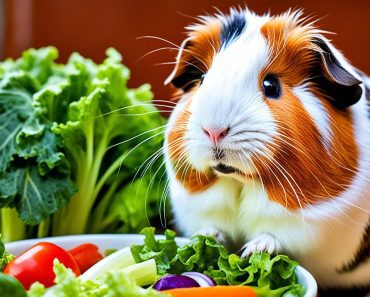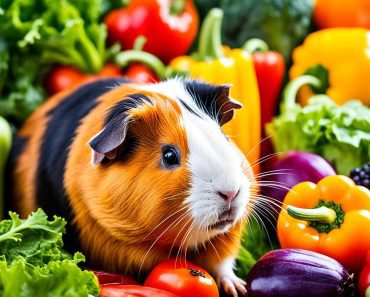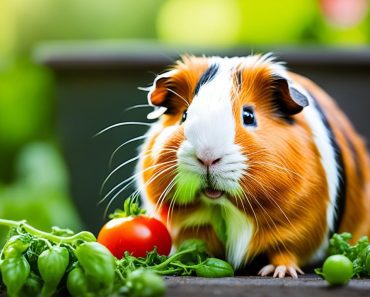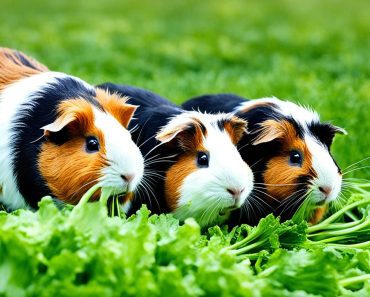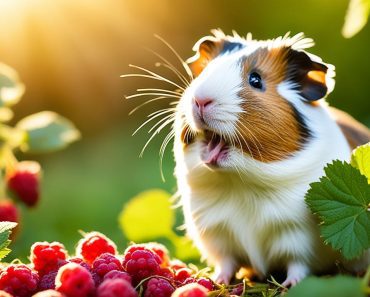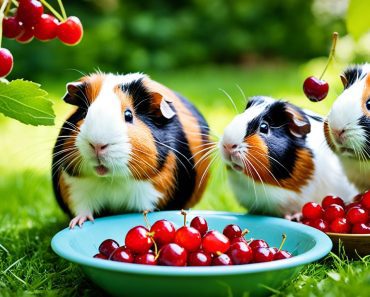Hi, I’m here to answer a common question that many guinea pig owners ask: Can guinea pigs eat cabbage? Well, the good news is that guinea pigs can indeed enjoy cabbage as part of their diet!
Guinea pigs are herbivores, and in the wild, they consume plant leaves, grass, and hay. As pets, it’s important to provide them with a similar diet to meet their nutritional needs. Cabbage is a great addition to their menu as it contains essential nutrients like vitamin C, fiber, and calcium.
However, it’s crucial to feed cabbage to your furry friends in moderation. Overfeeding can lead to digestive issues and potential urinary infections. Different varieties of cabbage have varying nutrient levels. For example, red cabbage is known for its high vitamin C content, while Savoy cabbage is rich in fiber.
Can Guinea Pigs Eat Cabbage? Yes, they can.
- Cabbage can be included in a guinea pig’s diet.
- It contains essential nutrients like vitamin C, fiber, and calcium.
- Feed cabbage in moderation to avoid digestive issues and urinary infections.
- Red cabbage is high in vitamin C, while Savoy cabbage is rich in fiber.
- Offer a balanced diet consisting of hay, commercial food pellets, and a variety of fresh vegetables.
Guinea Pig Diet for Optimal Health
When it comes to the diet of a guinea pig, there are a few key components that contribute to their overall health and well-being. A balanced combination of pellets, hay, and fresh vegetables is essential to meet their nutritional needs. Let’s break down the different elements of a guinea pig’s diet:
Hay: The Foundation of a Healthy Diet
Hay plays a crucial role in a guinea pig’s diet. It should make up approximately 75% of their daily food intake. Not only does hay aid in digestion, but it also helps wear down their continuously growing teeth. Timothy hay is an excellent choice for guinea pigs and provides them with the necessary fiber to support healthy digestion.
Pellets: A Supplemental Source of Nutrition
Guinea pig-specific pellets should be given in small amounts daily alongside hay. These pellets are formulated to provide the necessary vitamins and minerals that guinea pigs require. When choosing pellets, opt for ones that are high in fiber and contain limited amounts of added sugars. It’s important not to rely solely on pellets for their diet.
Fresh Vegetables: A Variety of Nutritious Options
Fresh vegetables are a vital component of a guinea pig’s diet, providing essential vitamins and nutrients. Leafy greens like romaine lettuce, kale, and parsley should make up the bulk of their vegetable intake. These greens are rich in vitamins and minerals that promote optimal health. Additionally, occasional treats of fruits like kiwis and strawberries can be given, but be cautious not to overfeed fruits due to their higher sugar content.
Water: A Constant Source of Hydration
Guinea pigs must have access to fresh water at all times. Ensure their water bottle is clean and filled regularly to keep them properly hydrated.
A well-balanced diet is crucial for guinea pigs to maintain optimal health. It’s essential to provide them with a constant supply of hay, supplemented with pellets and a variety of fresh vegetables. Additionally, always provide fresh water for proper hydration. Now that we’ve covered the basics of guinea pig nutrition, let’s take a closer look at the benefits and potential pitfalls of including cabbage in their diet.
The Benefits and Pitfalls of Cabbage for Guinea Pigs
Cabbage offers several benefits for guinea pigs. It is a crunchy and flavorful vegetable that can help maintain healthy teeth. Additionally, cabbage is a good source of essential nutrients like vitamin C, fiber, and calcium. However, it is important to remember that cabbage should not be the sole vegetable in a guinea pig’s diet.
Too much cabbage can have negative effects on guinea pigs. The high calcium content in cabbage can lead to health issues such as diarrhea, urinary infections, and kidney stones. Therefore, it is crucial to feed cabbage to guinea pigs in moderation.
To ensure a balanced diet, cabbage should be fed 2-3 times a week, along with a variety of other safe vegetables. Different varieties of cabbage offer varying nutrient profiles that further contribute to guinea pig nutrition.
Cabbage Varieties and Their Nutrient Profiles
When it comes to cabbage varieties, each has its own nutritional benefits:
| Cabbage Variety | Nutrient Profile |
|---|---|
| Red Cabbage | High in vitamin C, which supports immune function and overall health |
| Savoy Cabbage | Rich in fiber, aiding in digestion and promoting gut health |
| Napa Cabbage | Contains the highest levels of calcium among cabbage varieties, supporting bone health |
By incorporating a variety of cabbage types into a guinea pig’s diet, owners can ensure that their pets receive a range of essential nutrients.
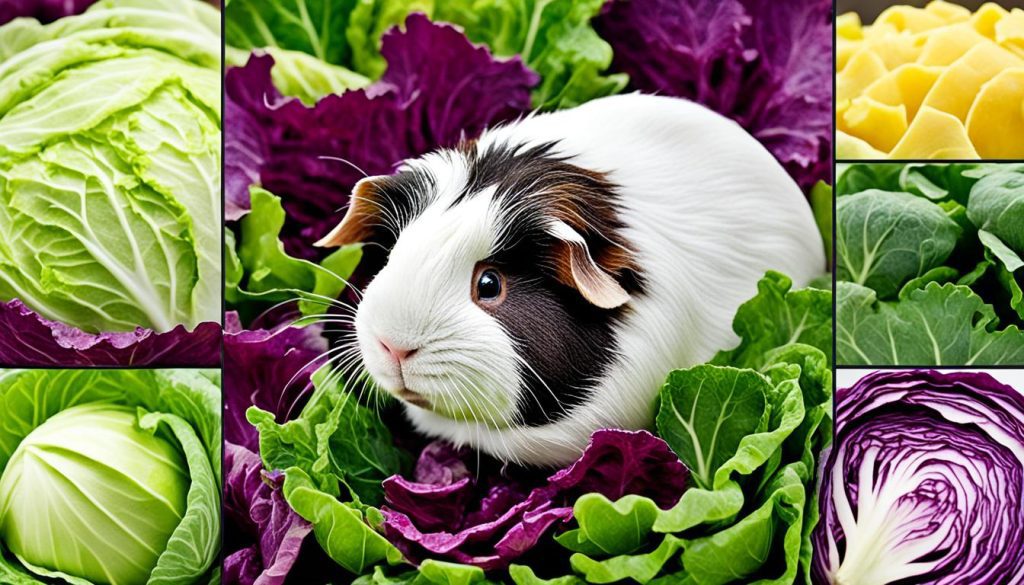
Overall, cabbage can be a beneficial addition to a guinea pig’s diet when fed in moderation. However, it is crucial to be mindful of the potential pitfalls associated with excessive cabbage consumption. Providing a varied, well-balanced diet consisting of safe vegetables and other nutritional components is key to ensuring the health and well-being of these adorable pets.
How to Safely Feed Cabbage to Your Guinea Pig
When it comes to introducing cabbage into your guinea pig’s diet, it’s important to start slowly and observe their response. Begin by offering a small amount, such as half a leaf, and monitor for any adverse effects, such as diarrhea. If your guinea pig tolerates the cabbage well, you can gradually increase the amount to a whole leaf. Typically, one whole leaf per feeding is sufficient to ensure they receive the nutritional benefits without overdoing it.
Remember that cabbage should only be fed to guinea pigs 2-3 times a week, as part of a varied diet. While cabbage provides important nutrients like vitamin C, fiber, and calcium, it should not be the only vegetable on their menu. To maintain a well-rounded diet, it’s crucial to offer a variety of other safe vegetables alongside cabbage.
Supplementing your guinea pig’s vegetable intake with commercial food pellets and high-quality hay is also necessary. This ensures they receive all the essential nutrients, vitamins, and minerals they need for optimal health and well-being. Hay should make up the majority of their diet, accounting for approximately 75% of their daily food intake.
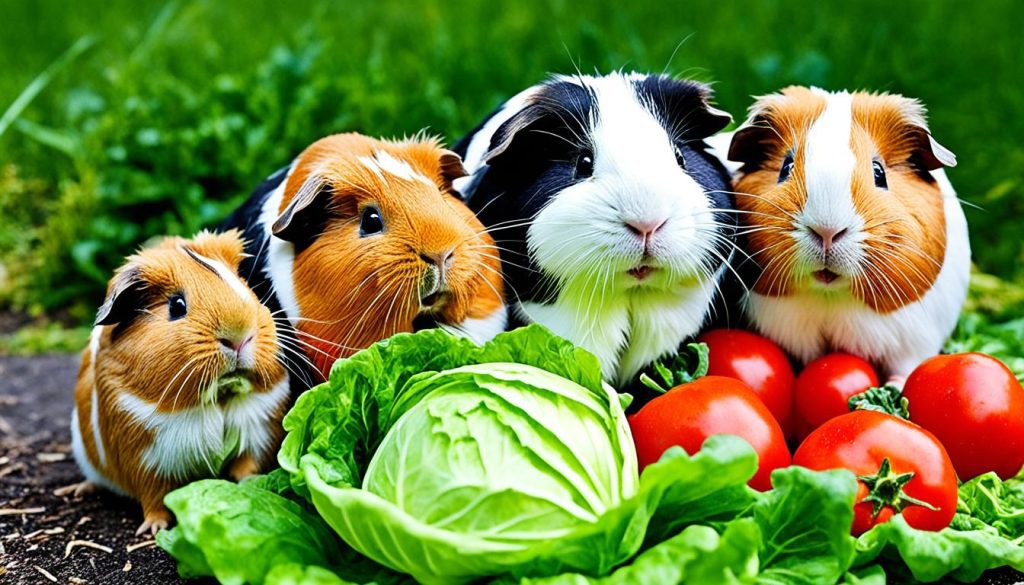
Providing a balanced diet that includes a combination of hay, veggies, and pellets is key to keeping your guinea pig healthy. By following these guidelines and monitoring their reactions, you can safely incorporate cabbage into their diet and provide them with the nutrition they need.
Other Considerations for Guinea Pig Nutrition
In addition to cabbage, it’s important to provide a variety of other vegetables to ensure a well-rounded diet for your guinea pig. Some safe and nutritious options include:
- Bell peppers
- Carrots
- Herbs like marjoram and rosemary
These vegetables not only provide essential nutrients but also add variety to your guinea pig’s meals. However, it’s important to remember that fruits should only be given as occasional treats due to their high sugar content. A balanced diet is key to maintaining your guinea pig’s nutrition and overall health.
Guinea pigs also require a constant supply of fresh grass hay in their daily diet. Hay aids in digestion, keeps their teeth healthy, and provides mental stimulation. It should make up the majority of their diet, with around 75% of their daily intake consisting of hay.
Commercial food pellets, specifically formulated for guinea pigs, can be given in smaller amounts as a supplement to hay and fresh vegetables. These pellets often come fortified with essential vitamins and minerals, including vitamin C, which is important for guinea pig nutrition. However, hay should always be the primary component of their diet.
To ensure the optimal health and well-being of your guinea pig, it’s crucial to avoid overfeeding and maintain a balanced diet. Regularly monitor their weight and consult with a veterinarian for personalized advice on guinea pig nutrition and care.
| Vegetables | Benefits | Recommended Frequency |
|---|---|---|
| Bell Peppers | Rich in vitamin C and antioxidants | 2-3 times a week |
| Carrots | Good source of vitamin A and beta-carotene | 2-3 times a week |
| Herbs (marjoram and rosemary) | Provide added flavor and variety | 2-3 times a week |
Conclusion
It is safe to incorporate cabbage into a guinea pig’s diet, but it should be given in moderation. Varieties such as red, Savoy, and Napa cabbage are all suitable options as they provide vital nutrients like vitamin C, fiber, and calcium. However, excessive cabbage consumption can potentially lead to digestive issues and urinary infections in guinea pigs.
To ensure optimal health for your guinea pig, it is crucial to provide a well-balanced diet that includes hay, commercial food pellets, and a variety of fresh vegetables. Hay should make up a significant portion of their diet to aid digestion and promote healthy teeth. Commercial food pellets specifically formulated for guinea pigs can supplement their nutrition needs.
Alongside cabbage, it is important to offer other safe vegetables for guinea pigs, such as bell peppers, carrots, and herbs like marjoram and rosemary. However, fruits should only be given occasionally due to their high sugar content. Regular weight monitoring and veterinary guidance are vital in ensuring the overall care and well-being of your guinea pig. By following these guidelines, you can help maintain a healthy and happy guinea pig.

